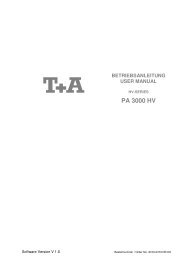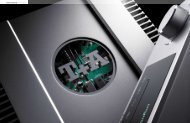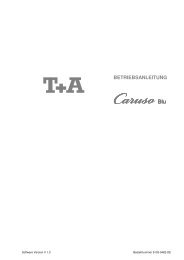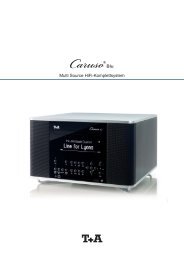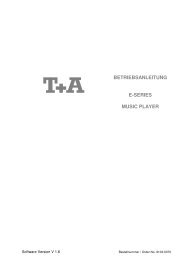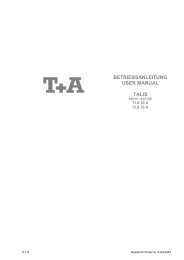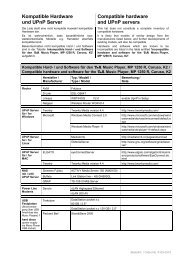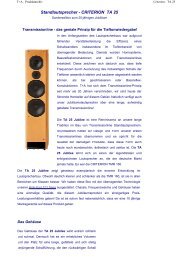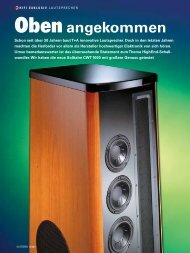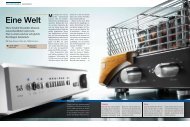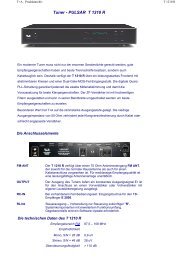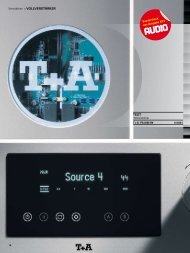CD player - PULSAR CD 1500 R - T+A Elektroakustik
CD player - PULSAR CD 1500 R - T+A Elektroakustik
CD player - PULSAR CD 1500 R - T+A Elektroakustik
Create successful ePaper yourself
Turn your PDF publications into a flip-book with our unique Google optimized e-Paper software.
<strong>CD</strong> <strong>player</strong> - <strong>PULSAR</strong> <strong>CD</strong> <strong>1500</strong> R<br />
The <strong>CD</strong> <strong>1500</strong> R employs a fully programmable signal processor (DSP) which can process<br />
digital signals in any conceivable way. For this reason it produces better oversampling<br />
characteristics than are possible otherwise using ready-made commercially available chips.<br />
Commercial oversampling filters are invariably designed to produce as flat a frequency<br />
response as possible, without taking into account time-related characteristics, i.e. those<br />
concerning transient response. The inevitable result is long pre- and post-echoes which can<br />
seriously distort the listener’s perception of the music - especially where peak signals are<br />
concerned.<br />
Different types of filter - known as polynomial filters - are now available which exhibit perfect<br />
transient signal handling. Unfortunately these filters show a slight drop in treble response at<br />
20 kHz. The <strong>CD</strong> <strong>1500</strong> R makes use of one class of these filters - BEZIER polynomial filters<br />
- combined with an IIR filter in a three-stage oversampling process.<br />
The result is a filter which produces no pre-echoes. The human ear is particularly sensitive<br />
to pre-echoes for two reasons: on the one hand they never occur at all under natural<br />
conditions, and on the other they are not masked by the main signal - as is the case with<br />
post-echoes. This filter also has a flat frequency response, which is a considerable<br />
improvement over other polynomial filters (e.g. cubic splines).<br />
Since filters of such refinement cannot be purchased ready-made, the <strong>CD</strong> <strong>1500</strong> R utilises a<br />
digital signal processor to fulfil this purpose.<br />
Since the signal processor is completely programmable the <strong>CD</strong> <strong>1500</strong> R is not tied to a<br />
particular filter type. As a result we have been able to give the machine a total of five<br />
different filter types, each with a different sound character, ranging from the classic long<br />
FIR filter to the BEZIER filter, with short FIR filters between the two.<br />
Each of these filters can be activated directly via its own button on the machine’s front<br />
panel.<br />
Connection elements<br />
<strong>CD</strong> <strong>1500</strong> R
<strong>T+A</strong> - Produktarchiv<br />
ANALOG OUT Asymmetrical analogue output for use with co-axial cables<br />
terminating in Cinch plugs.<br />
VOLUME CONTROL This slide switch can be used to set the <strong>CD</strong> <strong>1500</strong> R to either of<br />
two modes of operation: in the ‘OFF’ position the unit is in <strong>CD</strong><br />
<strong>player</strong> mode. In this mode the volume control of the unit does<br />
not affect the overall volume, but instead adjusts the output<br />
level. If the switch is set to ‘ON’, the unit operates in preamplifier<br />
mode. In this mode the volume control on the unit<br />
controls overall volume, and mirrors the volume control on<br />
the remote control handset.<br />
ON / OFF This slide switch switches the digital outputs (optical and coaxial)<br />
on / off.<br />
DIGITAL OUT (optical) Digital output for use with light-pipe cables.<br />
DIGITAL OUT (co-axial) Co-axial digital output for use with co-axial cables terminating<br />
in Cinch plugs<br />
RC IN RC input socket for connection to an "R"-series pre-amplifier,<br />
integrated amplifier or receiver.<br />
Standard-filter (long FIR-filter)<br />
The long FIR-filter is the standard oversampling filter used in digital technology.<br />
Advantages: Extremely linear frequency response in the audible range, very high stop band<br />
attenuation, linear phase, constant group delay.<br />
Filter 1 (short FIR-filter)<br />
The short FIR-filter has similar characteristics to the long FIR filter, but very much lower<br />
coefficient (160) and consequently considerably lower pre- and post-echoes. Advantages:<br />
Extremely linear frequency response in the audible range, high stop band attenuation, linear<br />
phase, constant group delay.<br />
Filter 2 (IIR-filter)<br />
This filter is a classic 8th order IIR-filter. It exhibits absolutely no pre-echo effects, albeit a<br />
slight tendency to post-echo. This is also a feature of natural instruments, and in any case<br />
the post-echo is usually masked by the normal audible signal. Advantages: No pre-echo at<br />
all, no treble loss, very high stop band attenuation.<br />
Filter 3 (Bezier- / IIR-filter)<br />
This combination circuit consists of three cascaded filters: a Bezier filter, an IIR filter and a<br />
second Bezier filter. It represents a good compromise between transient response and<br />
frequency response. Advantages: Virtually no pre-echo, minimal post-echo (in masking<br />
range), relatively flat frequency response, no pronounced treble loss.<br />
Filter 4 (Bezier-filter)<br />
The Bezier-filter is the ideal filter in terms of transient response, virtually no pre- or post-<br />
echo, linear phase, slight treble roll-off at 20 kHz. Advantages: Optimum transient response,<br />
linear phase, constant group delay.<br />
2-way converter<br />
Multi-bit and Sigma/Delta (1-bit) converters both offer their own unique advantages in terms<br />
of sound quality.<br />
Multi-bit converters provide a particularly powerful but rounded sound, especially in the bass<br />
part of the frequency range, whereas Sigma/Delta converters offer unexcelled fine detail<br />
<strong>CD</strong> <strong>1500</strong> R
<strong>T+A</strong> - Produktarchiv<br />
and resolution in the treble range.<br />
In the D/A conversion section of the <strong>CD</strong> <strong>1500</strong> R the frequency spectrum is divided up into<br />
two part-ranges, each of which is processed by its own set of converters.<br />
The advantage of this technique is that each part of the frequency range is processed by the<br />
converter technology best suited to it.<br />
BURR-BROWN multi-bit converters (maximum K selectivity) for the bass range<br />
NPC Sigma/Delta converter for the mid-range / treble range<br />
This complex arrangement combines the positive qualities of multi-bit converters (tight,<br />
rounded, powerful bass) with the complementary features of fine detail resolution and low<br />
distortion which are characteristic of Sigma/Delta converters.<br />
In both cases these converters are implemented in the form of complex double-differential<br />
circuits. This type of circuit design requires a total of eight individual converters, but the<br />
outstanding dynamics and overall reduction in hiss and harmonic distortion are so<br />
impressive that they easily justify the extra complexity.<br />
Analogue filters<br />
The analogue section of the <strong>CD</strong> <strong>1500</strong> R features a consistent policy of symmetrical,<br />
channel-separate (double-mono) construction. Channel symmetry is maintained throughout<br />
the circuit, and is established at the digital level where there is no chance of phase errors.<br />
The advantage of this arrangement is that a symmetrical signal is generated without the<br />
danger of introducing phase and amplitude errors.<br />
All four converters on each channel are operated in the optimum double-differential mode,<br />
which reduces the hiss level of the converters by an additional 3 dB.<br />
However, we have maintained the symmetrical construction even in the analogue<br />
reconstruction low-pass circuits, the volume control and the output stages.<br />
The advantage of this sophisticated type of circuit design lies in the fact that no earth<br />
currents are present in the filter stages or the output and control stages, with the result that<br />
the analogue signal earth stays extremely clean.<br />
Output stages<br />
We have developed a new circuit for our output stages:<br />
We have abandoned the use of standard operational amplifiers (op-amps) in favour of a<br />
combination of a high-quality BURR-BROWN audio op-amp followed by a driver amplifier<br />
(BURR-BROWN BUF 634 T).<br />
The driver amplifier features very high bandwidth (180 MHz), high slew rate (1800 V/µ s)<br />
and good current supply capacity (250 mA).<br />
These characteristics mean that it can drive practically any cable of any length.<br />
This in turn means that the audio op-amp is relieved of the stress of driving the capacitive<br />
load represented by the cable, and therefore works even more accurately than in a standard<br />
configuration.<br />
<strong>CD</strong> mechanism<br />
The machine is based on a close-tolerance linear drive mechanism, now combined with an<br />
<strong>CD</strong> <strong>1500</strong> R
<strong>T+A</strong> - Produktarchiv<br />
improved, newly developed precision support plate made of rigid, machined brass with a<br />
galvanically gold-plated finish. This component eliminates mechanical resonances in the <strong>CD</strong><br />
virtually completely.<br />
The <strong>CD</strong> mechanism is isolated from the case and the atmosphere with extreme<br />
effectiveness by a complex, laminated 5-layer housing, supplementary internal<br />
encapsulation, and a mechanical three-point suspension system which supports the<br />
mechanism module in bonded rubber buffers.<br />
A statistical assessment of the c1/c2 error rates shows that this arrangement reduces the<br />
mechanism’s sensitivity to vibration and sound by more than 20 dB.<br />
Mains section<br />
The analogue and digital sections of the <strong>CD</strong> <strong>1500</strong> R are powered by completely separate<br />
mains sections. This means that the danger of impairment in the analogue section due to<br />
digital interference signals on the secondary side is eliminated.<br />
We have also developed new transformers and complementary mains filters in order to<br />
preclude any undesirable coupling of interference signals on the primary side of the mains<br />
section.<br />
These new "C-core" transformers feature a static shield winding which suppresses the<br />
coupling capacitance of the primary and secondary side of the transformers virtually<br />
completely.<br />
Specifications<br />
Mechanism Professional, close-tolerance linear disc<br />
mechanism, completely encapsulated for<br />
vibration de-coupling, mechanical threepoint<br />
suspension, triple-beam LDGU optics,<br />
780 nm semi-conductor laser, 2mW power<br />
Wow and flutter Quartz-controlled, not measurable<br />
Mechanical construction Rigid metal case, multi-shielded subassemblies,<br />
multi vibration de-coupled,<br />
mechanism air-isolated by own housing<br />
Digital filters Freely programmable signal processor with<br />
five different filter types, 8-times<br />
oversampling and 56-bit resolution, FIR<br />
short FIR long, IIR, Bezier, Bezier IIR filters,<br />
no HD<strong>CD</strong><br />
Noise shaping 4th order (ZSNS)<br />
Analogue filter Phase-linear Bessel filter, 3rd order with 60<br />
kHz limit frequency<br />
Frequency response 2 Hz – 20 kHz<br />
Distortion / intermodulation < 0,0015 %<br />
Effektive system dynamics 98 dB<br />
Signal: noise ratio (A-weighted) 110 dB<br />
Signal: noise ratio (unweighted) 107 dB<br />
Channel separation 1 kHz / 10 kHz > 107 / 107 dB<br />
Digital output Data format SP-DIF<br />
1 x opto = 660 nm / - 18 dBm<br />
1 x coax = 0,5 V / 75 Ohms<br />
optional: optical output<br />
<strong>CD</strong> <strong>1500</strong> R
<strong>T+A</strong> - Produktarchiv<br />
Analogue output Digital volume control<br />
Cinch nominal 2,6 V eff, 10 Ohms<br />
Dimensions 15 x 44 x 39 cm<br />
Weight 18 kg<br />
We reserve the right to alter technical specifications.<br />
Colours Black (9005), silver (Lack)<br />
Remote control Via R system or as non-standard version<br />
Special features Completely separate analogue and digital<br />
mains power supplies, 3 transformers,<br />
galvanic separation between analogue and<br />
digital sections<br />
<strong>CD</strong> <strong>1500</strong> R



